Is the We Can Do It Poster Art Deco
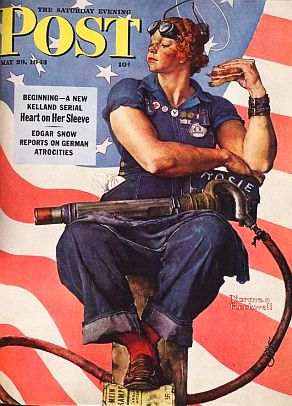
Norman Rockwell's 'Rosie The Riveter' encompass for the May 29, 1943 edition of The Sabbatum Evening Mail, was the first visual image to contain the 'Rosie' name.
"Rosie the Riveter" is the proper name of a fictional graphic symbol who came to symbolize the millions of real women who filled America's factories, munitions plants, and shipyards during Globe War II. In later on years, Rosie also became an iconic American prototype in the fight to augment women's civil rights.
Later the Japanese bombing of Pearl Harbor in December 1941 and the full interest of the U.S. in World War 2, the male work strength was depleted to fill the ranks of the U.Southward. military. This came precisely at a time when America'south need for factory output and munitions soared.
The U.S. government, with the assistance of advertising agencies such as J. Walter Thompson, mounted extensive campaigns to encourage women to bring together the piece of work strength. Magazines and posters played a central part in the effort to recruit women for the wartime workforce.
Saturday Evening Post embrace artist, Norman Rockwell, is by and large credited with creating 1 of the popular "Rosie the Riveter" images used to encourage women to become wartime workers.
Rockwell'due south "Rosie," shown at right, appeared on the cover of the May 29th, 1943 edition of The Saturday Evening Post. The Post was then one of the nation's most popular magazines, with a circulation of about 3 million copies each week. In addition to Rockwell'due south Rosie, all the same, another paradigm would become the more commonly known "Rosie the Riveter" paradigm.

J. Howard Miller's 'We Tin can Exercise It!' affiche, commissioned by Westinghouse and shown briefly in Feb 1942. Click for copy.
Westinghouse Posters
In 1942, Pittsburgh artist J. Howard Miller was hired past the Westinghouse Company's War Production Coordinating Committee to create a series of posters to motivate employees for the war effort. One of these posters became the famous "We Can Do It!" image — an image that in later years would besides get known by many every bit "Rosie the Riveter," though that was not the intended purpose at its creation. In fact, at the time of the poster'southward release the name "Rosie" was in no way associated with Miller's image. The poster — one of 42 produced in Miller'southward Westinghouse series — was used exclusively within Westinghouse and not initially seen much beyond several Westinghouse factories in Pennsylvania and the Midwest where information technology was displayed for ii weeks in February 1943. It was only years afterward, after the Miller affiche was rediscovered in 1982 – some 40 years later on, in fact – that his rendering began to be associated with "Rosie The Riveter," and more importantly, women'southward liberation and other causes.
In terms of the origin of Miller's "We Tin can Practice It!" image, in that location have been some reports that an bodily WWII adult female worker may accept been used as the source and/or inspiration – either from a photo or equally an in-person studio model. A 1942 wire service photo of one WWII female worker at Alameda Naval Air Base of operations in California dressed in bandanna and work clothes has been suggested equally a possible source, but i friend of Miller's has noted that he rarely worked from photographs.
Both images, even so — Rockwell's and Miller'due south — were used to help motivate the WWII workforce, but in Miller'south case, possibly but at Westinghouse factories. But Rockwell's "Rosie," in particular, helped encourage female workers to fill up WW 2 production jobs. Sheridan Harvey of the U.S. Library of Congress has noted: "Rosie'due south appearance on the Memorial Solar day cover of the Sat Evening Post implied that her work might help save soldiers' lives." And in after years, up to present times, both of these images – Miller's and Rockwell's – have become iconic symbols of women's rights struggles and are occasionally adapted for other causes and political campaigns equally well. But in whatsoever case, information technology was during the World War Two years that "Rosie the Riveter" got her start.
"Rosie the Riveter"
Vocal Lyrics
While other girls attend their fav'rite
cocktail bar
Sipping Martinis, munching caviar
In that location'south a daughter who's really putting
them to shame
Rosie is her name
All the day long whether rain or shine
She'southward a office of the assembly line
She's making history,
working for victory
Rosie the Riveter
Keeps a sharp spotter for sabotage
Sitting upwardly there on the fuselage
That little frail tin practice more than a
male will do
Rosie the Riveter
Rosie's got a boyfriend, Charlie
Charlie, he'south a Marine
Rosie is protecting Charlie
Working overtime on the
riveting car
When they gave her a production "Eastward"
She was as proud as a girl could exist
There's something truthful most
Red, white, and bluish about
Rosie the Riveter
Everyone stops to admire the scene
Rosie at work on the B-Xix
She'south never twittery, nervous or jittery
Rosie the Riveter
What if she'southward smeared full of
oil and grease
Doing her fleck for the old Lendlease
She keeps the gang around
They love to hang around
Rosie the Riveter
Rosie buys a lot of war bonds
That girl really has sense
Wishes she could purchase
more bonds
Putting all her cash into national
defense
Senator Jones who is "in the know"
Shouted these words on the radio
Berlin volition hear virtually
Moscow will cheer about
Rosie the Riveter!
_____________________
Paramount Music Corporation, NY,
1942. Mind to song at YouTube.
First, The Song
Rosie the Riveter appears to have come outset in song, not in art. In 1942, a song titled "Rosie the Riveter" was written by Redd Evans and John Jacob Loeb and was issued by Paramount Music Corporation of New York. The vocal was released in early on 1943 and was played on the radio and broadcast nationally. Information technology was also performed by various artists with popular band leaders of that day.
The song, it turns out, was inspired by a paper story about a xix-year old female riveter named Rosalind Palmer who worked at the Vought Shipping Company in Stratford, Connecticut riveting the bodies of Corsair fighter planes. That Rosie – perhaps the first Rosie – was known as "Roz" by friends, and would become Rosalind P. Walter, a famous and long-time benefactor of PBS and WNET in New York. She was built-in into a prosperous N Shore Long Island family – her begetter, Carleton Palmer, was president and and then chairman of E.R. Squibb and Sons, a drug visitor fabricated prosperous by WWII penicillin (at present part of Bristol Myers Squibb), and her mother, Due west. Bushnell, a professor of literature at Long Island Academy. Rosalind, a prep school student who might have gone off to college at Smith or Vassar, instead heeded the WWII call for female person workers. Syndicated newspaper columnist, Igor Cassini, took up her story, writing near Rosalind the riveter in his "Cholly Knickerbocker" column. That story, in turn, inspired the songwriters Evans and Loeb – and since information technology was syndicated in many newspapers — possibly Rockwell too.
The song, meanwhile, became quite popular, peculiarly one version recorded past the Four Vagabonds, an African-American group — a version that caught on and rose on the Hit Parade. It seems likely that Saturday Evening Post artist Norman Rockwell heard this song, and mayhap was influenced by it, especially since he wrote the name "Rosie" on the luncheon box in his painting.
In theMail service'southward cover illustration, Rockwell's Rosie is shown on her lunch intermission, eating a sandwich from her opened dejeuner pail as her riveting gun rests on her lap. A giant American flag waves behind her. Rosie appears content, gazing off into the altitude. However, Rockwell portrays her with some of import details, from the lace handkerchief visible in her correct mitt pocket, to her foot placed smack on the embrace of Adolph Hitler's Mein Kampf at the bottom of the painting. But there was also something else in Rockwell's Rosie.
The "Isaiah Effect"
In early June 1943, later on The Saturday Evening Postcover of Rosie had striking the newsstands and had been widely circulated, the Kansas Metropolis Star paper ran images of Rockwell's Rosie alongside of Michelangelo's Isaiah from his Sistine Chapel ceiling painting. The splash in the Star drew a lot more attention to Rockwell'due south Rosie. Followers of Rockwell's illustrations in those years knew well his penchant for touches of humor and satire.
In more recent years, reviewers of Rockwell'south Rosie take added their interpretations and observations. "Just every bit Isaiah was called by God to convert the wicked from their sinful means and bruise evildoers under foot," wrote i Sotheby's curator in a May 2002 review, "and so Rockwell's Rosie tramples Hitler under her all-American penny loafer."
Rockwell had used a petite local adult female every bit a model for his Rosie — Mary Doyle (Keefe), then a 19 year-old phone operator — but he took liberties with her actual proportions to make his Rosie announced every bit a more powerful, Isaiah-like figure.
"Righteousness is described throughout Isaiah'south prophecy as God's 'strong right arm'," continued the Sotheby's reviewer, "a characterization that must surely have occurred to [Rockwell] equally he portrayed Rosie's muscular forearms." Rockwell's Rosie likewise has a halo floating only to a higher place the pushed-back visor on her caput.Rockwell's "Rosie" was subsequently donated to the U.South. State of war Loan Bulldoze and briefly went on a public bout. Rockwell had fun with his paintings, using some irreverent humor here and there, merely also including the necessary serious messages and patriotic tone.
Rockwell's Sat Evening Post Rosie was widely disseminated during the war. In addition to the magazine'southward 3 one thousand thousand-plus apportionment, Rockwell's Rosie was too displayed in other publications, including The Art Assimilate of July 1, 1943. Withal, Rockwell'due south epitome of Rosie might have enjoyed an even wider apportionment had it non been for the actions of the magazine's publisher, Curtis Publishing. In 1943, Curtis initially used the phrase "Rosie the Riveter" on posters it distributed to news dealers advertising the forthcoming Mail service issue with Rockwell'due south painting on the cover. However, according to writer Penny Colman, within a few days, Curtis sent telegrams to the news dealers ordering them to destroy the poster and render a notarized statement attesting to the fact that they had. Curtis issued its retraction because it feared being sued for copyright infringement of the recently released song "Rosie the Riveter." Rockwell'south painting of Rosie was and then donated to the U.S. Treasury Department'due south War Loan Drive, and and then went on a bout for public display in diverse cities across the country.
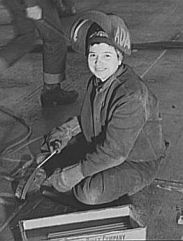
A 'Wendy-the-Welder' in 1940s' shipbuilding at Richmond, CA.
Real Life Rosies
In June 1943, about two weeks after Rockwell's Sabbatum Evening Post cover appeared on newsstands, the press picked upwardly the story of a woman worker named Rose Bonavita-Hickey. She and partner Jennie Florio, drilled 900 holes and placed a record three,345 rivets in a torpedo-bombing Avenger shipping at the former Full general Motors Eastern Aircraft Partition in North Tarrytown, New York.
Hickey's feat was recognized with a personal letter from President Roosevelt, and became identified as one of many real-life "Rosie the Riveters." Other women workers doing riveting — as well as others mostly who were filling heavy-industry "men's" jobs all across the nation – e.g., "Wendy-the-welders," etc. — too gained media attention during the state of war years.
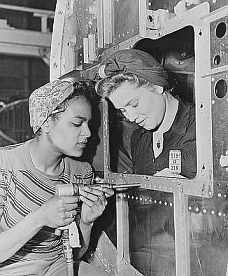
WWII-era photograph showing Dora Miles and Dorothy Johnson at Douglas Aircraft Co. found in Long Beach, CA.
Sybil Lewis, an African-American riveter who worked for Lockheed Aircraft in Los Angeles, would later provide this description of women riveters:
"The women worked in pairs. I was the riveter and this large, strong, white girl from a cotton farm in Arkansas worked as the bucker. The riveter used a gun to shoot rivets through the metal and spike information technology together. The bucker used a bucking bar on the other side of the metal to smoothen out the rivets. Bucking was harder than shooting rivets; it required more muscle. Riveting required more than skill."
In early on Baronial 1943, Life mag featured a full comprehend photo of a adult female steelworker, along with an inside photo-story spread of other "Rosie" steelworkers, some quite dramatic.
The photographs were taken past Margaret Bourke-White, the famous Life photojournalist who was the first female person war correspondent and the starting time woman to be allowed to piece of work in combat zones during Earth War II.

Life magazine embrace photo of August 9, 1943 shows steel-worker Ann Zarik at work with her torch. Click for copy.
Bourke-White had spent much of WWII in the thick of things overseas, merely likewise managed to do domestic stories such as the "Women in Steel" spread, which included at least a dozen photographs displayed in Life's Baronial 9, 1943 edition. These photos captured women at work in the American steel industry, including some taken at Tubular Alloy Steel Corp. of Gary, Indiana and Carnegie-Illinois Steel Company.
Some of the photos showed the women wielding torches and working on heavy plate and structural steel with sparks flying, with others working among behemothic steel caldrons that carried the molten steel. A display of these and other Rosie photographs, culled from the Life magazine archive, tin be seen at "The Many Faces of Rosie The Riveter, 1941-1945."
Demand More Women
The authorities, meanwhile, continued to telephone call for more women in the workforce. They needed women to work in all kinds of jobs, not just those in munitions plants or military-related mill work. By September 1943, the Magazine War Guide was asking magazine publishers to participate in a "Women at Piece of work Embrace Promotion." They wanted publishers and others to push button all kinds of employment as vital "state of war jobs." Everyday "civilian jobs" were vital, too, not just the factory jobs. The slogan for this promotion was: "The More Women at Work the Sooner We Win."
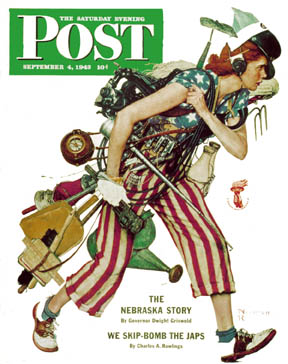
Norman Rockwell's portrayal of American 'liberty girl' in her 'jack-of-all-trades' way, capable of doing many kinds of civilian jobs to help the War effort – September four, 1943, Saturday Evening Mail.
The Saturday Evening Post used Norman Rockwell once more to produce a embrace for this entrada — a cover that appeared on its September 4th, 1943 event. Information technology was entitled "Rosie To The Rescue." For this cover, Rockwell created a "liberty girl" dressed in patriotic wearing apparel but bandage every bit a jack-of-all-trades composite, capable of doing whatever number of civilian jobs — nurse, mechanic, telephone operator, milkman, farmer, etc. This "liberty daughter" image did not resonate the same manner that Rosie did, merely Rockwell and the publishers were nevertheless doing their part for the War try.
Rockwell and The Saturday Evening Postal service were only part of a much bigger campaign to motility women into the workplace. Motion pictures, newspapers, radio, museums, employee publications, and in-store displays were all involved. Some 125 million advertisements were produced every bit posters and full-folio magazine ads.
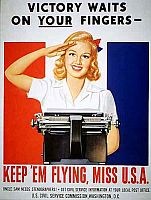
Fine print reads: 'Uncle Sam Needs Stenographers. Become Civil Service Information at Your Post Part.'Click for copy.
In fact, the govern- ment was quite direct almost the propaganda campaign it needed to mountain. According to the Basic Plan Plan for Womanpower in the Office of War Information, for instance: "These jobs volition have to be glorified as a patriotic war service if American women are to be persuaded to have them and stick to them. Their importance to a nation engaged in total war must be convincingly presented."

A 'WOW' was a 'Adult female Ord-nance Worker.' Click for copy.
Some promotional films were produced equally well. Hollywood role player Walter Pidgeon, working for the regime State of war Bond endeavor, made a short film promoting the state of war effort in which he recruited a real "Rosie the Riveter" worker named Rose Will Monroe whom he met while touring Ford Motor'south Willow Run aircraft factory. The curt film was shown in theaters between featured films to encourage viewers to buy War Bonds.
Unrelated to the War Bond effort, a Hollywood movie called Rosie the Riveter was also fabricated in 1944; information technology was a B-grade romantic wartime one-act fabricated by Democracy studios with Jane Frazee as Rosie Warren who worked in an plane factory.

Female person trainees at Middletown, PA, 1944. The Middletown Air Service Command stockpiled parts and overhauled military airplanes. During WWII, Middletown'southward workforce grew from 500 to more than 18,000, about one-half of them women.
Women's Work
The women who responded to "Rosie'southward call" during the 1940s' war years did all kinds of piece of work. In 1942, the Kaiser shipyards opened in Richmond, California, becoming a major shipbuilding center for the state of war effort. A woman named Bethena Moore from Derrider, Louisina was one of thousands who came to work there. In Louisiana, she had been a laundry worker. A small woman of 110 pounds, Bethena was 1 of the workers who would climb down into the bowels of ships — sometimes iv stories in depth — on a narrow steel ladder, tethered to a welding machine. She did the welds on the ships' double-bottoms. "It was night, scary," she later recounted to a New York Times reporter in October 2000. "It felt sad, because there was a war on. You knew why yous were doing information technology — the men overseas might non get back. There were lives involved. So the welding had to be perfect."
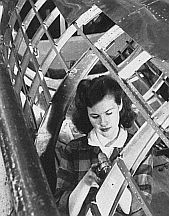
Woman working inside the tail of a B-17 aircraft at Boeing product line in Seattle, WA, 1940s.
Phyllis McKey Gould was another worker at the Richmond, California Kaiser shipyard No. 2. She worked as a welder there, later recalling the work she did: "I'd never worked in my life," she said. "I loved the look of welding, the smell of it… You lot'd expect through really dark glass and all you'd see was the glow. You moved the welding rod in tiny, circular motions, making half-crescents. If you did it correct, it was beautiful. It was like embroidery." At the war's summit, women, many of them African-American, made up more a quarter of the Richmond shipyards' 90,000 workers.
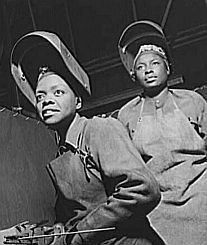
Women welders at Landers, Frary & Clark Establish, New Britain, Connecticut, 1943.
In Maine during the early 1940s, Dorothy "Dot" Kelley was recently divorced, out on her own, and raising four children. Later seeing women from the Portland shipyard cashing $600 checks, she quit her job at a Montgomery Ward department store and went to work at the South Portland Shipyards. She worked there helping build ships from 1942 until the shipyard closed in 1945. She worked nights so her days could be free for her children. Dot and other the women welders wore heavy dress against the cold, and they wriggled into the ships's tight spaces to weld its seams together. Her neck and chest became spotted with tiny burn down marks from the sparks — common to other welders also. But after the war ended, Dot Kelley was forced to work two jobs, and her children were sometimes left to fend for themselves at home. She was determined, still, to keep working and continue her family unit together. She lived to be 94 years former, and through her girl, National Public Radio told her story in a December 2006 broadcast.
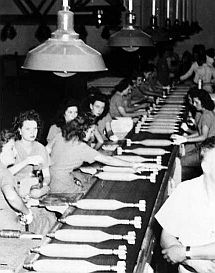
Women working at the Redstone Arsenal in Alabama, 1940s.
In Georgia, Eloise Strom, a young mother of two young boys, rose every morning before dark and rode an 60 minutes and a one-half in a automobile pool with v other women to go to work at the aircraft plant in Marietta. Some worked in the role, others worked in product. In the early 1940s the found was called the "Bong Bomber plant," subsequently to become Lockheed-Martin. During WWII, information technology employed some 28,263 workers at its peak — virtually 10,000 of them women. It then paid well higher up the minimum wage. The factory produced B-29 bombers — some 668 in all. The B-29s were used mainly in the Pacific Theater to bomb Japan; they had a longer range than the B-17s used in Europe. The Marietta found not only reshaped the work force, it too transformed Marietta from a sleepy boondocks of 8,000 into a booming industrial eye.
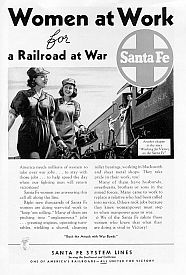
Sante Iron Railroad advertizing singing the praises of its women workers.
About Hunstville, Ala- bama, a armed forces ordnance complex known equally the Redstone Arsenal, also used women throughout its facilities. By Dec 1942, about 40 percent of Redstone product line employees were women, and that share would rise to 60 per centum or more than on some production lines by war's end. Dealing with munitions, chemicals, and other dangerous substances, the jobs at Redstone entailed a caste of hazard, and several women were killed there during the WWII years, with a number of others injured.
In Michigan, at Ford Motor Co., more than than thirty percent of Ford workers in 1943 in the machining and assembly departments were women. Women at Ford plants built jeeps, B-24 aircraft, and tractors. They likewise became test pilots for the B-24s. And they operated drill presses, welding tools, heavy casting machinery and riveting guns.
The Sante Fe Railroad too used women in state of war-time jobs. I of the company's wartime ads explained in role: "…Right now, thousands of Santa Atomic number 26 women are doing war-vital work to 'keep-em-rolling'. Many of them are pitching into 'unglamourous jobs'… greasing engines, operating turntables, wielding a shovel, cleaning roller bearings, working in blacksmith and canvass metal shops. They take pride in their work likewise!" A modest inset box in the advertizing as well read: "Another affiliate in the story 'Working for Victory on the Sante Atomic number 26'."
Marilyn "Rosie" Monroe
June 1945
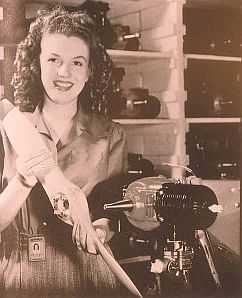
Marilyn Monroe, earlier she became a Hollywood star, appeared in a serial of aeroplane manufactory photos in June 1945 that led to her becoming a model and film star.
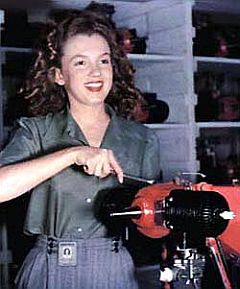
Some other of David Conover'south photos of xix year-one-time Norma Jean Dougherty.
Opening The Door
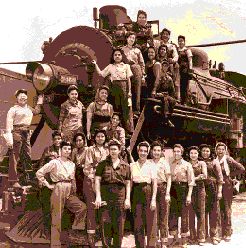
Mexican American women workers on the Southern Pacific Railroad during WW II.
During the WWII years, the regime's state of war-related "get-women-to-piece of work" campaigning opened the door to women in the workforce, setting off a key alter for women's civil rights and altering the demographics of the workforce in later years. At the end of December 1941, in that location were about 13 million women at piece of work. 'Rosie the Riveter' and other campaigns helped to increase that number to xv million in early 1943. Past 1944, there were twenty million women in the workforce, with 6 million of those working in factories. And according to the American Rosie the Riveter Association, the millions of Rosies who filled the factories helped turn out critical war materiel, including nearly 300,000 airplanes, more than than 100,000 tanks, and some 44 billion rounds of ammunition.
Although many of the jobs held by women during WWII were initially returned to men later on the state of war concluded, the workforce would never be the aforementioned again. Sybil Lewis, who worked as a Lockheed riveter during those years stated: "Y'all came out to California, put on your pants, and took your luncheon pail to a man's chore. This was the offset of women's feeling that they could practice something more." Inez Sauer, who worked as a Boeing tool clerk in the war years, put information technology this way:
"My mother warned me when I took the chore that I would never be the aforementioned. She said, 'Yous will never want to become back to existence a housewife.' At that time I didn't recollect information technology would change a affair. But she was correct, it definitely did. . . . at Boeing I institute a liberty and an independence that I had never known. After the war I could never become dorsum to playing bridge again, being a lodge woman . . . when I knew there were things you could use your listen for. The war inverse my life completely. I gauge you could say, at 30-one, I finally grew up."

Women at Douglas aircraft institute during WWII.
Women discovered a new sense of pride, nobility and independence in their work and their lives. Many realized their work was simply as valuable as men'due south, though for years, and to this day, an earnings disparity withal exists. During the state of war years, however, a number of women workers joined unions, gaining major new benefits from labor representation. Blackness and Hispanic women also gained entry to major industrial plants, factory and other jobs throughout the country. But the fight for equal rights in the workplace and equal pay for women was only commencement, and would be fought over many years following WWII.
Women'southward Lib
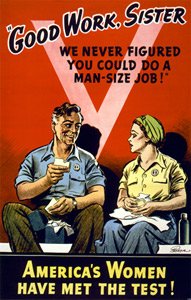
America's working women were praised during the war, only when the war ended they were encouraged to render to homemaking. Click for poster.
As the women'south rights movement emerged in the 1970s, Rosie the Riveter imagery was chosen upon for use in campaigning and popular literature. By the 1980s, the historical importance of the WWII "Rosie workers" began to be revisited in books and movie. One documentary pic entitled, The Life and Times of Rosie the Riveter, was fabricated by Connie Field, who originally got the idea for the film after attending a California Rosie-the-Riveter reunion. The film, released in September 1981, is based on all-encompassing research and some 700 interviews. It profiles five females who were working in low-paying jobs earlier the war and become wartime workers. The five "Rosies" recall their WW Two-era experiences working in Detroit, Los Angeles, New York and San Francisco. Their stories are interwoven with archival recruitment films, stills, posters, ads, and music from the menstruum.
The film's views contrast with some of the popular legends and mythology surrounding the Rosies of WW Ii, including the fact that many Rosies were denied opportunities to go on working one time the war ended. The motion picture is regarded every bit one of the all-time accounts of women working in heavy industry in World War II, and also of domicile-front life during those years. In the film's showtime year, some one one thousand thousand viewers saw it, a very high number for a documentary. It has likewise won diverse film festival prizes and was dubbed into half-dozen languages. In 1996, information technology was selected for preservation in the United States National Moving picture Registry past the Library of Congress as being "culturally, historically, or aesthetically meaning".
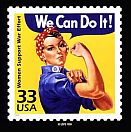
Rosie postage stamp, circa 1999.

'When America marched off to war, the women marched into the factories,' says this 1984 movie promo. 'From then on...aught was ever the same again.'
In 1984, Goldie Hawn'south Hollywood film, Swing Shift, fabricated with Warner Brothers, also built its storyline effectually the Rosie workers of World War Two. That film as well starred Christine Lahti, Kurt Russell, Fred Ward and Ed Harris. Swing Shift focuses more on the personal relationships of its WW 2-era female workers played by Hawn and Lahti while their husbands are away in the war. This film, still, too fairly portrayed what happened to women workers at the state of war'southward cease as male workers returned and the female person workers were no longer needed. In the 1990s, Rosie the Riveter imagery and stories continued to pop upwardly in diverse venues. Smithsonian magazine did a story on WWII era Rosie affiche fine art in its March 1994 edition, putting the J. Howard Miller "We Can Practise It" Rosie on the cover. In Nov 1998, the U.S. Postal Service authorized a new first-form postage stamp honoring the WW Two-era working women, also using the "Nosotros-Tin can-Practice-It!" Rosie.
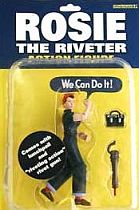
Rosie, the activeness figure.
And by this fourth dimension, likewise, at that place was all manner of Rosie-the-Riveter paraphernalia available — from T-shirts to Rosie action figures and bobble head dolls. The Rosie activeness effigy, for example, is a five-inch, all-plastic toy replica with moveable artillery, legs and head. It also comes with a lunch box and a "riveting activeness" rivet gun. 1 of the toy'southward merchants — having a piffling fun with his promotion — offered the post-obit play scenarios: "…You tin utilise her [Rosie] to beckon your Barbies out of their mansions and into the factories to exercise their role for the US of A. …Or, you can ignore her historical significance and pit her against your WWF [World Wrestling Federation] activity figures in a muzzle match battle extreme!"
Back in the real world, all the same, thousands of older Rosies who had really worked in the wartime production frenzy, were getting up in years, and many were recalling their experiences in their wartime jobs. Some were having reunions, while others began communicating with one another. In 1998, the "American Rosie the Riveter Association" was formed in Warm Springs, Georgia and is today headquarterd in Birmingham, Alabama. By 2004 this arrangement had 1,400-members. In California, meanwhile, something else was afoot: a National Park (follows beneath the Rockwell sidebar).
Rockwell's Rosie & Beyond
Rising Value
Over the years, Norman Rockwell's Rosie the Riveter has by and large yielded in popularity to the J. Howard Miller/Westinghouse "We Tin Do It!" poster daughter. Copyright restrictions on Rockwell's Rosie in subsequent years meant it was less ofttimes reproduced. The Miller/Westinghouse poster image, on the other hand, was without such copyright limitations, and over the years, appeared in numerous forms — on coffee mugs, magnets, t-shirts, and mouse pads. Still, Rockwell's original painting had some interesting travels. …By the 1990s, certainly, Rockwell's body of work had received serious attention of historians and art critics alike… And in the art world, Rockwell'due south Rosie enjoyed a considerable following. In the 1940s, afterward Rockwell's painting was donated to the government War Bond effort, it went on public tour, equally did other works of fine art during those years. Items on these tours were sometimes offered as prizes in raffles equally a way to increase public interest and contributions for the war attempt. Reportedly, at 1 of those events — believed to have been when the painting was displayed at the Strawbridge & Clothier store in Philadelphia, Pennsylvania — Rockwell's original Rosie was raffled off and won by a Mrs. P. R. Eichenberg of Mount Lebanon, Pennsylvania. After that, the painting appears to have been caused by the Chicago Pneumatic Tool Co. on E. 44th St. in New York city, where it was hung in a display window next to a placard explaining Rosie's history. Also included in that window display were some riveting hammers identical to the one Rockwell's painting placed in Rosie'southward lap. After its window brandish, it appears that Rosie was held by Martha Parrish and James Reinish of New York.

Rockwell'southward Rosie painting sold for millions. Click for wall print.
"Rockwell's pictures often honored the American spirit," wrote Judy Larson and Maureen Hart Hennessey in their 1999 book,Norman Rockwell: Pictures for the American People. "Particularly during times of crisis, Rockwell created images that communicated patriotism and unquestioned allegiance to the United States."
Others would write that his Rosie the Riveter was a attestation to the indomitable force of the American spirit during one of the nation's most challenging times. "Rosie'southward cool self confidence, sheer physical might, and unwavering support of her state," said 1, "parallel the force, decision and patriotism of the American people."
One-time in the year 2000, the original Rockwell Rosie painting was sold to an bearding collector for $two million. By 2002, that collector decided to sell. In the concurrently, Rockwell's Rosie had been part of an all Norman Rockwell exhibition entitled "Norman Rockwell: Pictures for the American People," which had run at the Solomon R. Guggenheim Museum in New York from November 1999-February 2002. In 2002, Rockwell's Rosie was sold at Sotheby's for $4.95 1000000. Rockwell'southward Rosie had illustrated the exhibit brochure'due south back cover as well as interior pages. Later on the exhibition, it was and then featured on the comprehend of Sotheby's May 2002 American Paintings auction mag. The auction was held on May 22, 2002. The bidding on Rockwell's "Rosie the Riveter" painting began at $1.5 million and proceeded in $100,000 increments until information technology was sold for $4,959,500. The buyers were a husband-and-wife team — Kelly Elliott owner of the Elliott Yeary Gallery of Aspen, Colorado, and her husband, Jason Elliott, a partner in Ranger Endowments Management of Dallas, Texas.
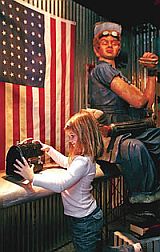
Isabella Keiser, 7, checks out Rosie'southward luncheon pail. Photo, Leonardo Carrizo, Columbus Acceleration.
Beyond "Rosie the Riveter," Norman Rockwell'due south work today is even so admired broadly throughout America. Museum exhibits of Rockwell's work at The Sabbatum Evening Post and elsewhere have appeared over the years throughout the country. In Columbus, Ohio, for instance, during February-March 2009, in that location was a "Rockwell's America" exhibit at the Ohio Historical Center in Columbus, Ohio. A photo from the Rosie the Riveter portion of that exhibit appears at left. There is as well the Norman Rockwell Museum in Stockbridge, Massachusetts, where Rockwell lived the terminal 25 years of his life. Founded in 1969, it holds the earth's largest drove of original Rockwell art — some 574 original works also as the Norman Rockwell Athenaeum of photographs, fan post, and other documents.
Rosie Memorial & Park
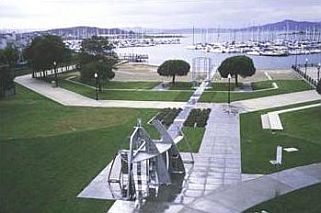
Rosie the Riveter Memorial looking out toward Richmond Marina & San Francisco Bay beyond. This site was formerly Kaiser Shipyard No. 2.
On Oct 14th, 2000, a "Rosie the Riveter memorial" was dedicated in Richmond, California, a location on the San Francisco Bay where one of WWII's amazing engineering science feats took place — with women workers playing a primal role. For it was hither that Kaiser shipbuilding devised mass-assembly techniques to more quickly produce the vessels that were needed in the war. In that undertaking, Richmond became a Mecca for workers, as other factories, including a Ford Motor plant, were also converted to war-time production of jeeps and other equipment. In the 1990s, with some of these sites deteriorating and/or fading in memory, a few local officials sought to better their locale and depict tourist and public attention to the historic role women workers had played at some of these locations. A modest "Rosie the Riveter" memorial was first proposed at the site of one the Kaiser shipbuilding docks, and work began in the belatedly 1990s. Only this memorial before long sparked, and became function of, a much larger vision and plan that would come to encompass the "Rosie the Riveter WW II Abode Front National Historical Park" — a U.Southward. National Park with multiple venues and historic sites along Richmond's 22-mile waterfront.
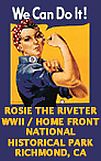
Rosie park poster.
In the U.S. Congress, legislation authorizing the "Rosie the Riveter WWII Domicile Forepart National Historical Park" was submitted by U.Southward. Rep. George Miller (D-CA), U.South. Senator Barbara Boxer (D-CA), and U.Southward. Senator Diane Feinstein (D-CA) in March of 2000. The bill was signed into police past President Bill Clinton in October 2000.
"Preservation is not simply for parks and wilderness areas," said Congressman George Miller at the bill's signing. "Nosotros are also committed to using our resource to preserve celebrated sites that assist tell the story of America's development, and the Rosie the Riveter Home Front National Historical Park will stand up as a lasting tribute to these brave women who played such a crucial role in winning the war." Today, the park includes a number of exhibits on the "homefront" and "Rosie-the-Riveter" contributions to the WWII-era production that took place in Richmond. Other exhibits for the park are also planned.
View toward Bay from hull sculpture looking downward walkway. Engraved pavement sections are visible as well as "prototype ladders" with period photographs & shipyard memorabilia.
At the October 2000 dedication of the Rosie the Riveter memorial, for example, hundreds of visitors and dignitaries came to the ceremony, non the least of whom were some 200 "Rosies" returning to the former workplace to revisit their past.
The memorial, which includes a sculpture of role of a ship'southward hull under construction, evokes the ship edifice that went on at that place, with a granite walkway that stretches the length of a Liberty transport the to the water's edge. The granite walkway includes etched words from women workers. The site as well includes "image ladders" with photographs and memorabilia, and a timeline of events on the habitation front and individual memories of the period.
On the overlook platform at the memorial, in a prominent location, is the following quote for all to read: "You must tell your children, putting modesty bated, that without us, without women, there would have been no leap in 1945."
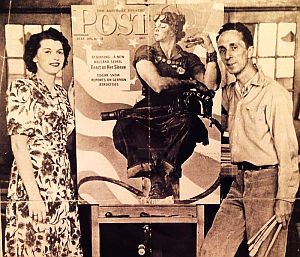
Norman Rockwell with Mary Doyle Keefe, the model for the 1943 'Rosie-the-Riveter' Saturday Evening Mail service cover.
Additional stories at this website on notable women include, for example, those on author and ecologist Rachel Carson and her book, Silent Jump; Olympics star and pro golfer, Babe Didrikson; and vocaliser and TV celebrity Dinah Shore. The topics folio, "Noteworthy Ladies," offers more than than 40 story choices on women who accept fabricated their marker in diverse fields.
Additional history on the piece of work of Norman Rockwell tin can exist constitute at "Rockwell & Race, 1963-1968," and more on Saturday Evening Post embrace art is included at "Falter's Fine art, Rising"(John Falter covers, 1940s-1960s) and "U.South. Post Function, 1950s-2011" featuring the work of Stevan Dohanos and other Post illustrators.
Thanks for visiting – and if you like what you lot notice here, please make a donation to help support the research and writing at this website.. Give thanks yous. – Jack Doyle
_________________________________
Date Posted: 28 February 2009
Last Update: 15 December 2020
Comments to: jdoyle@pophistorydig.com
Article Commendation:
Jack Doyle, "Rosie The Riveter, 1941-1945,"
PopHistoryDig.com, February 28, 2009.
_________________________________
Sources, Links & Additional Information
| |
| |
| |
| |
| |
| |
| |
| |
Transcript of video presentation by Sheridan Harvey, "Rosie the Riveter: Real Women Workers in Earth War Two," Library of Congress, Washington., D.C., date of presentation not stated.
"Rosie The Riveter," Wikipedia.org.
"Women'southward Piece of work," Click! The Ongoing Feminist Revo-lution (web showroom), ClioHistory.org/click/, 2015.
"Northrop Workers Show 35,000 Visitors How Planes Are Built, Los Angeles Times, December 28, 1942, p. A-ane.
Norman Rockwell's "Rosie The Riveter" illustration appears in, The Kansas Metropolis Star, June 6, 1943.
Jeannette Guiterrez, "Naomi Parker Fraley, The Original 'We Can Do It!' Gal," Diary of A Rosie.com (site focused on saving Willow Run bomber constitute & more), March 11, 2016.
"The statesO. to Open Women War Workers' Club," Los Angeles Times, June 21, 1943, p.13.
"Nosotros Can Exercise Information technology!," Wikipedia.org.
Aline Law, "Women Practice a Lot to Keep 'Em Flying; Bout of Plane Plant Reveals Proportion High," Los Angeles Times, November 28, 1943, p. D-xiii.
"Rosie the Riveter Keeps Her Glamour in Shape; Special Beauty Treatments at Douglas Plant Retain Girls' Looks for Subsequently-State of war Dwelling Life," Los Angeles Times, October 1, 1944, p. 12.
"Marilyn Monroe," Wikipedia.org.
Commodity on the Norman Rockwell "Rosie the Riveter" painting, Art Digest, Apr 15, 1945, p. 18.
"Riveter Rosie Asks Human'southward Pay, Woman'due south Rights," Los Angeles Times, December 10, 1944, p. xiii.
"Women War Workers Quit Plants in Droves," Los Angeles Times, Dec 17, 1945, p. one.
The Life and Times of Rosie The Riveter, a documentary pic produced and directed by Connie Field, 1981.
C. Gerald Fraser, "Rosie's Life later the War Was Not So Rosy," New York Times, Saturday, May 2, 1981, p. 13.
Maureen Love, Creating Rosie the Riveter, Amherst: The University of Massachusetts Press, 1984.
Sherna B. Gluck, Rosie the Riveter Revisited, Boston, Twayne Publishers, 1987.
Laura 50. Dresser and Sherri A. Kossoudji, "The Cease of a Riveting Experience: Occupational Shifts at Ford After World War II," American Economic Review, May 1992.
"Powers of Persuasion: Affiche Art From Earth State of war II," The National Athenaeum, From an Exhibit in Washington, D.C., May 1994 – Feb 1995.
Penny Colman, Rosie the Riveter: Women Working on the Home Forepart in World State of war Ii, Crown Books, 1995.
Dr. Kaylene Hughes, "Women at War: Redstone'due south WWII Female person Product Soldiers," paper originally written past Dr. Kaylene Hughes, Senior Historian, U.Due south. Army Missile Command Historical Office, for presentation to the U.S. Regular army Historians Conference, June 1994. The paper was adjusted to volume-format by Dr. Hughes in early on 1995.
Tony Marcano, "Famed Riveter In War Effort, Rose Monroe Dies at 77," New York Times, June 2, 1997.
National Public Radio (NPR), "Rosie the Riveter" [Re: Rose Monroe's death], All Things Considered, June 2, 1997.
Megan Garrett, "Folk Hero Rosie The Riveter and Women's Labor," Lewis & Clark College, Portland, Oregon, April 23, 1998.
U.Southward. Army Ordnance Corps. "Rosie the Riveter: More Than a Poster Girl," October 1, 1998.
Joanne Klement, "Stamp Will Accolade `Rosie the Riveter," Knight Ridder/Tribune News Service, November ten, 1998.
Thou. Paul Holsinger, "Rosie The Riveter," War and American Pop Civilization: A Historical Encyclopedia, 1998.
Judy Larson and Maureen Hart Hennessey, Norman Rockwell: Pictures for the American People, New York, 1999.
Maureen Honey, Creating Rosie the Riveter: Class, Gender, and Propaganda During World War 2, Academy of Missouri Printing, 1999.
Shirley Ann Wilson Moore, To Identify Our Deeds: The African American Community in Richmond, California 1910-1963, Academy of California Press, January 2000.
Patricia Leigh Brown, 'Rosie the Riveter' Honored in California Memorial," New York Times, Oct 22, 2000.
"Rosie Gets Her National Park as Clinton Signs Miller's Neb," RosieTheRiveter.org., Wash., DC, October 25, 2000.
Carol Vogel, "Inside Art: And Rosie's Notwithstanding Riveting," New York Times, Apr 5, 2002.
James Barron, "The Model for 'Rosie,' Without Rivets or Brawn," New York Times, May nineteen, 2002.
Dara Mitchell, "Riveting Rosie," Sotheby's Sale Preview, American Paintings, 1334 York Avenue, New York, May 22, 2002.
James Barron, "Boldface Names: An Admirer Lands 'Rosie'," New York Times, May 23, 2002.
Penny Colman, Letter to the Editor, "Information technology's Just 'Rosie'," New York Times, May 24, 2002.
"Rockwell's Rosie the Riveter Painting Auctioned," RosieTheRiveter.org
Jeffry Scott, "Efforts To Recognize 'Rosie the Riveters' Picks Up Momentum," The Atlanta Journal-Con-stitution, December 7, 2004.
"Women in War Jobs – Rosie the Riveter (1942-1945)," Advertisement Council.org.
National Park Service Website, Rosie The Riveter / WWII Homefront National Park.
Aerial view of featured sites at Rosie The Riveter National Park.
"Yank, the Ground forces Weekly," Wikipedia.org.
Ford Motor Co., "The Real Story of 'Rosie the Riveter:' A Ford Motor Company Employee," Ford.com.
Lincoln Cushing, "'Rosie the Riveter' Is Non the Aforementioned as 'Nosotros Tin Do Information technology!'," DocsPopuli.org.
James J. Kimble and Lester C. Olson, "Visual Rhetoric Representing Rosie the Riveter: Myth and Miscon-ception in J. Howard Miller's 'Nosotros Can Do Information technology!' Affiche," Rhetoric & Public Affairs, Vol. 9, No. 4, Wintertime 2006, pp. 533-569.
"Rosie The Riveter: Wars and Battles, World War II Home Forepart," U-S-History.com.
National Public Radio (NPR), "My Female parent's Story: Dot the Welder," past Joyce Butler, on Morning Edition by Michael Garofalo; senior producer for StoryCorps Sarah Kramer, December fifteen, 2006.
Photographs, etc., "Boeing Aircraft Plant Seattle Washington in WW Ii."
An excellent collection of "Rosie worker" photographs, culled from the Life magazine annal, is displayed at "The Many Faces of Rosie The Riveter, 1941-1945."
Margaret Bourke-White, "Women in Steel" (photograph-graphs), Life, August nine, 1943.
Carol Vogel, "A Billionaire's Eye for Art Shapes Her Singular Museum," New York Times, June 16, 2011.
Website, Crystal Bridges Museum of American Art, Bentonville, Arkansas.
Roger Hurlburt, "Monroe An Showroom Of The Early Days Of Marilyn Monroe — Before She Became A Legend — Brings The Star`s History In Focus," SunSentinel.com (Florida) January half-dozen, 1991.
"David Conover," Wikipedia.org.
"Marilyn Monroe," Webster's Online Dictionary.
"USA Edition, YANK United states of america 1945," WarTimePress.com, (re: annotation on Marilyn Monroe).
Julie Zauzmer, "Rosie The Riveter, 70 Years After: Women Who Stepped Into Nontraditional Jobs During World War II Think Their Work With Pride," Washington Post, Aug. xi, 2014, p. B-1.
Joseph Berger, "Rosalind P. Walter, the First 'Rosie the Riveter,' Is Dead at 95," New York Times, March 5, 2020.
____________________________
Source: https://www.pophistorydig.com/topics/tag/we-can-do-it-poster/
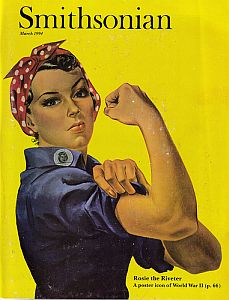
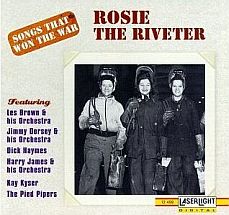
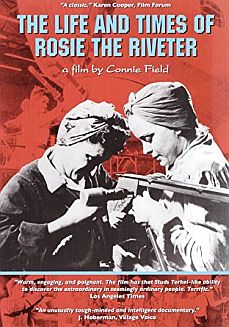
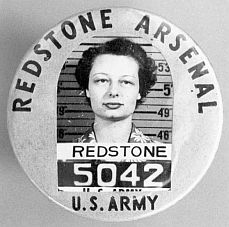
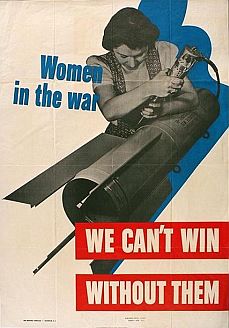
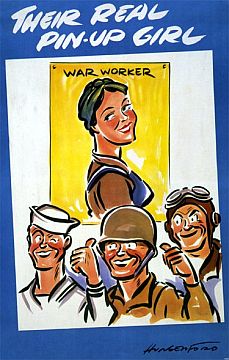
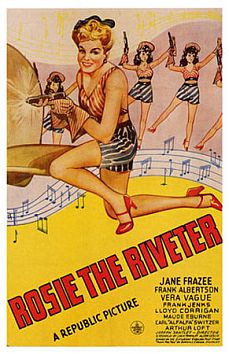

0 Response to "Is the We Can Do It Poster Art Deco"
Post a Comment